Related Research Articles

Sir Isaac Newton was an English polymath active as a mathematician, physicist, astronomer, alchemist, theologian, and author who was described in his time as a natural philosopher. He was a key figure in the Scientific Revolution and the Enlightenment that followed. His pioneering book Philosophiæ Naturalis Principia Mathematica, first published in 1687, consolidated many previous results and established classical mechanics. Newton also made seminal contributions to optics, and shares credit with German mathematician Gottfried Wilhelm Leibniz for developing infinitesimal calculus, though he developed calculus years before Leibniz. He is considered one of the greatest and most influential scientists in history.

In astronomy, Kepler's laws of planetary motion, published by Johannes Kepler between 1609 and 1619, describe the orbits of planets around the Sun. The laws modified the heliocentric theory of Nicolaus Copernicus, replacing its circular orbits and epicycles with elliptical trajectories, and explaining how planetary velocities vary. The three laws state that:
- The orbit of a planet is an ellipse with the Sun at one of the two foci.
- A line segment joining a planet and the Sun sweeps out equal areas during equal intervals of time.
- The square of a planet's orbital period is proportional to the cube of the length of the semi-major axis of its orbit.

Mass is an intrinsic property of a body. It was traditionally believed to be related to the quantity of matter in a body, until the discovery of the atom and particle physics. It was found that different atoms and different elementary particles, theoretically with the same amount of matter, have nonetheless different masses. Mass in modern physics has multiple definitions which are conceptually distinct, but physically equivalent. Mass can be experimentally defined as a measure of the body's inertia, meaning the resistance to acceleration when a net force is applied. The object's mass also determines the strength of its gravitational attraction to other bodies.

The tidal force or tide-generating force is a gravitational effect that stretches a body along the line towards and away from the center of mass of another body due to spatial variations in strength in gravitational field from the other body. It is responsible for the tides and related phenomena, including solid-earth tides, tidal locking, breaking apart of celestial bodies and formation of ring systems within the Roche limit, and in extreme cases, spaghettification of objects. It arises because the gravitational field exerted on one body by another is not constant across its parts: the nearer side is attracted more strongly than the farther side. The difference is positive in the near side and negative in the far side, which causes a body to get stretched. Thus, the tidal force is also known as the differential force, residual force, or secondary effect of the gravitational field.
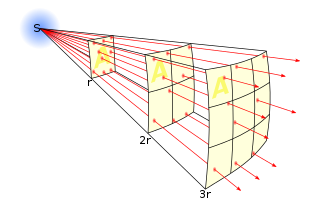
In science, an inverse-square law is any scientific law stating that the observed "intensity" of a specified physical quantity is inversely proportional to the square of the distance from the source of that physical quantity. The fundamental cause for this can be understood as geometric dilution corresponding to point-source radiation into three-dimensional space.
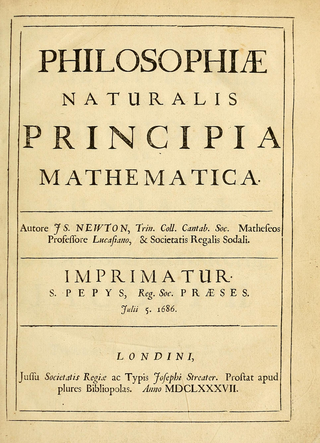
Philosophiæ Naturalis Principia Mathematica often referred to as simply the Principia, is a book by Isaac Newton that expounds Newton's laws of motion and his law of universal gravitation. The Principia is written in Latin and comprises three volumes, and was first published on 5 July 1687.

Robert Hooke FRS. was an English polymath active as a scientist, natural philosopher and architect, who is credited as one of the first two scientists to discover microorganisms using a compound microscope that he built himself. An impoverished scientific inquirer in young adulthood, he became one of the most important scientists of his day and found wealth and esteem by performing over half of the property surveys after London's great fire of 1666 and assisting in the city's rapid reconstruction. In recent times, he has been called "England's Leonardo".
The following is a timeline of classical mechanics:
Celestial mechanics is the branch of astronomy that deals with the motions of objects in outer space. Historically, celestial mechanics applies principles of physics to astronomical objects, such as stars and planets, to produce ephemeris data.
Newton's law of universal gravitation says that every particle attracts every other particle in the universe with a force that is proportional to the product of their masses and inversely proportional to the square of the distance between their centers. Separated objects attract and are attracted as if all their mass were concentrated at their centers. The publication of the law has become known as the "first great unification", as it marked the unification of the previously described phenomena of gravity on Earth with known astronomical behaviors.
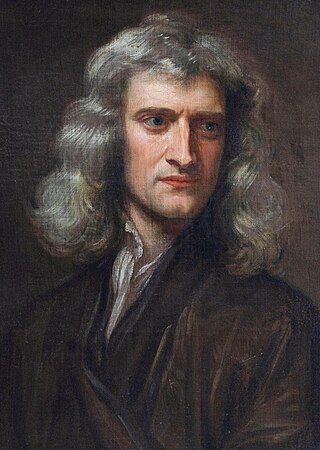
The following article is part of a biography of Sir Isaac Newton, the English mathematician and scientist, author of the Principia. It portrays the years after Newton's birth in 1642, his education, as well as his early scientific contributions, before the writing of his main work, the Principia Mathematica, in 1685.
According to ancient and medieval science, aether, also known as the fifth element or quintessence, is the material that fills the region of the universe beyond the terrestrial sphere. The concept of aether was used in several theories to explain several natural phenomena, such as the propagation of light and gravity. In the late 19th century, physicists postulated that aether permeated space, providing a medium through which light could travel in a vacuum, but evidence for the presence of such a medium was not found in the Michelson–Morley experiment, and this result has been interpreted to mean that no luminiferous aether exists.
De motu corporum in gyrum is the presumed title of a manuscript by Isaac Newton sent to Edmond Halley in November 1684. The manuscript was prompted by a visit from Halley earlier that year when he had questioned Newton about problems then occupying the minds of Halley and his scientific circle in London, including Sir Christopher Wren and Robert Hooke.
Lunar theory attempts to account for the motions of the Moon. There are many small variations in the Moon's motion, and many attempts have been made to account for them. After centuries of being problematic, lunar motion can now be modeled to a very high degree of accuracy.

In the history of calculus, the calculus controversy was an argument between the mathematicians Isaac Newton and Gottfried Wilhelm Leibniz over who had first invented calculus. The question was a major intellectual controversy, which began simmering in 1699 and broke out in full force in 1711. Leibniz had published his work first, but Newton's supporters accused Leibniz of plagiarizing Newton's unpublished ideas. Leibniz died in 1716, shortly after the Royal Society, of which Newton was a member, found in Newton's favor. The modern consensus is that the two men developed their ideas independently.
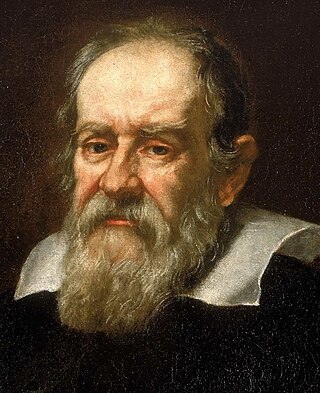
In physics, theories of gravitation postulate mechanisms of interaction governing the movements of bodies with mass. There have been numerous theories of gravitation since ancient times. The first extant sources discussing such theories are found in ancient Greek philosophy. This work was furthered through the Middle Ages by Indian, Islamic, and European scientists, before gaining great strides during the Renaissance and Scientific Revolution—culminating in the formulation of Newton's law of gravity. This was superseded by Albert Einstein's theory of relativity in the early 20th century.
Mechanical explanations of gravitation are attempts to explain the action of gravity by aid of basic mechanical processes, such as pressure forces caused by pushes, without the use of any action at a distance. These theories were developed from the 16th until the 19th century in connection with the aether. However, such models are no longer regarded as viable theories within the mainstream scientific community and general relativity is now the standard model to describe gravitation without the use of actions at a distance. Modern "quantum gravity" hypotheses also attempt to describe gravity by more fundamental processes such as particle fields, but they are not based on classical mechanics.

In classical mechanics, Newton's theorem of revolving orbits identifies the type of central force needed to multiply the angular speed of a particle by a factor k without affecting its radial motion. Newton applied his theorem to understanding the overall rotation of orbits that is observed for the Moon and planets. The term "radial motion" signifies the motion towards or away from the center of force, whereas the angular motion is perpendicular to the radial motion.
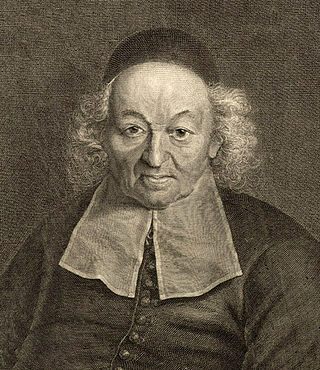
Ismaël Boulliau was a 17th-century French astronomer and mathematician who was also interested in history, theology, classical studies, and philology. He was an active member of the Republic of Letters, an intellectual community that exchanged ideas. An early defender of the ideas of Copernicus, Kepler and Galileo, Ismael Bullialdus has been called "the most noted astronomer of his generation". One of his books is Astronomia Philolaica (1645).
In physics, the n-body problem is the problem of predicting the individual motions of a group of celestial objects interacting with each other gravitationally. Solving this problem has been motivated by the desire to understand the motions of the Sun, Moon, planets, and visible stars. In the 20th century, understanding the dynamics of globular cluster star systems became an important n-body problem. The n-body problem in general relativity is considerably more difficult to solve due to additional factors like time and space distortions.
References
- ↑ H W Turnbull (ed.), Correspondence of Isaac Newton, Vol 2 (1676–1687), (Cambridge University Press, 1960), giving the Halley–Newton correspondence of May to July 1686 about Hooke's claims at pp. 431–448, see particularly page 431.
- ↑ Discussion points can be seen for example in the following papers:
- Guicciardini, Niccolò (2005). "Reconsidering the Hooke–Newton Debate on Gravitation: Recent Results". Early Science and Medicine. 10 (4): 510–517. doi:10.1163/157338205774661825. JSTOR 4130420.
- Gal, Ofer (2005). "The Invention of Celestial Mechanics". Early Science and Medicine. 10 (4): 529–534. doi:10.1163/157338205774661834. JSTOR 4130422.
- Nauenberg, M. (2005). "Hooke's and Newton's Contributions to the Early Development of Orbital mechanics and Universal Gravitation". Early Science and Medicine. 10 (4): 518–528. doi:10.1163/157338205774661861. JSTOR 4130421.
- 1 2 Bullialdus (Ismael Bouillau) (1645), "Astronomia philolaica", Paris, 1645.
- 1 2 Borelli, G. A., "Theoricae Mediceorum Planetarum ex causis physicis deductae", Florence, 1666.
- 1 2 See especially p. 13 in Whiteside, D. T. (1970). "Before the Principia: The Maturing of Newton's Thoughts on Dynamical Astronomy, 1664–1684". Journal for the History of Astronomy. 1: 5–19. Bibcode:1970JHA.....1....5W. doi:10.1177/002182867000100103. S2CID 125845242.
- 1 2 Hooke's 1674 statement in "An Attempt to Prove the Motion of the Earth from Observations" is available in online facsimile here.
- ↑ Purrington, Robert D. (2009). The First Professional Scientist: Robert Hooke and the Royal Society of London. Springer. p. 168. ISBN 978-3-0346-0036-1. Extract of page 168
- ↑ See page 239 in Curtis Wilson (1989), "The Newtonian achievement in astronomy", ch.13 (pages 233–274) in "Planetary astronomy from the Renaissance to the rise of astrophysics: 2A: Tycho Brahe to Newton", CUP 1989.
- ↑ Page 309 in H W Turnbull (ed.), Correspondence of Isaac Newton, Vol 2 (1676–1687), (Cambridge University Press, 1960), document #239.
- ↑ See Curtis Wilson (1989) at page 244.
- ↑ Page 297 in H W Turnbull (ed.), Correspondence of Isaac Newton, Vol 2 (1676–1687), (Cambridge University Press, 1960), document #235, 24 November 1679.
- ↑ Page 433 in H W Turnbull (ed.), Correspondence of Isaac Newton, Vol 2 (1676–1687), (Cambridge University Press, 1960), document #286, 27 May 1686.
- 1 2 Pages 435–440 in H W Turnbull (ed.), Correspondence of Isaac Newton, Vol 2 (1676–1687), (Cambridge University Press, 1960), document #288, 20 June 1686.
- ↑ Page 436, Correspondence, Vol.2, already cited.
- ↑ Propositions 70 to 75 in Book 1, for example in the 1729 English translation of the Principia, start at page 263.
- ↑ Propositions 43 to 45 in Book 1, in the 1729 English translation of the Principia, start at page 177.
- ↑ See especially pp. 13–20 in Whiteside, D. T. (1991). "The Prehistory of the 'Principia' from 1664 to 1686". Notes and Records of the Royal Society of London. 45 (1): 11–61. doi: 10.1098/rsnr.1991.0002 . JSTOR 531520.
- ↑ See J. Bruce Brackenridge, "The key to Newton's dynamics: the Kepler problem and the Principia", (University of California Press, 1995), especially at pages 20–21.
- ↑ See for example the 1729 English translation of the Principia, at page 66.
- ↑ See especially p. 10 in Whiteside, D. T. (1970). "Before the Principia: The Maturing of Newton's Thoughts on Dynamical Astronomy, 1664–1684". Journal for the History of Astronomy. 1: 5–19. Bibcode:1970JHA.....1....5W. doi:10.1177/002182867000100103. S2CID 125845242.
- ↑ Gal, Ofer (2005). "The Invention of Celestial Mechanics". Early Science and Medicine. 10 (4): 529–534. doi:10.1163/157338205774661834. JSTOR 4130422.
- ↑ Guicciardini, Niccolò (2005). "Reconsidering the Hooke–Newton Debate on Gravitation: Recent Results". Early Science and Medicine. 10 (4): 510–517. doi:10.1163/157338205774661825. JSTOR 4130420.
- ↑ Nauenberg, M. (2005). "Hooke's and Newton's Contributions to the Early Development of Orbital mechanics and Universal Gravitation". Early Science and Medicine. 10 (4): 518–528. doi:10.1163/157338205774661861. JSTOR 4130421.
- ↑ See for example the results of Propositions 43–45 and 70–75 in Book 1, cited above.
- ↑ See also G E Smith, in Stanford Encyclopedia of Philosophy, "Newton's Philosophiae Naturalis Principia Mathematica".
- ↑ The second extract is quoted and translated in W.W. Rouse Ball, "An Essay on Newton's 'Principia'" (London and New York: Macmillan, 1893), at page 69.
- ↑ The original statements by Clairaut (in French) are found (with orthography here as in the original) in "Explication abregée du systême du monde, et explication des principaux phénomenes astronomiques tirée des Principes de M. Newton" (1759), at Introduction (section IX), page 6: "Il ne faut pas croire que cette idée ... de Hook diminue la gloire de M. Newton", and "L'exemple de Hook" [serve] "à faire voir quelle distance il y a entre une vérité entrevue & une vérité démontrée".